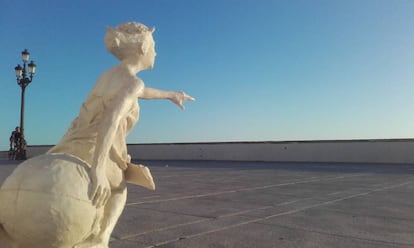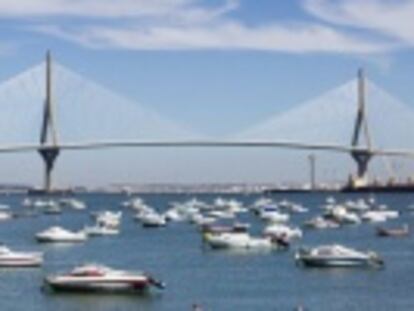In search of the lost meridian of Cadiz
Historian rescues from oblivion the longitude that put the Spanish port on the map
Medieval geographers believed the longitude of geographical coordinates was the limit placed by God on the intelligence of man. For centuries, countries such as Spain, England, Holland and France proposed competitions and offered generous rewards to anyone who could come up with an effective method to define the measurement. After all, the safety of ships and the accuracy of frontiers were at stake.

Unlike latitude and its geographical center, the Equator, there was no international consensus on which meridian should be set at zero degrees of longitude. For centuries, nations with their own meridian held power.
And Spain had a number of them – Madrid, Toledo, Isla del Hierro, Pico del Teide and Salamanca. But for an entire century, the Cadiz meridian was the most important point of reference for the Spanish fleet. And while it fell into disuse years before the international meridian in Greenwich was established, a study is currently being carried out to keep the memory of it alive.
For an entire century, the Cadiz meridian was the most important point of reference for the Spanish fleet
“From 1753 to 1850, most Spanish nautical charts and logbooks are drawn up in reference to the Cadiz meridian,” says the study’s author, Miguel Ramos, who has been investigating what it meant for the city. “It had great international significance and maritime prestige, but there is nothing in the city today that alludes to it.”
The Cadiz meridian became a guide for Spanish navigation in 1717, the year the city became the seat of the Real Casa de Contratación de Indias, a government agency of the Spanish Empire, existing from the 16th to the 18th centuries, that oversaw trade with the colonies.
Cadiz’s new and powerful business link with the Americas brought the city huge financial benefits and led to other developments such as the founding of the first Academy of the Marine Guards of the Spanish Armada in 1717, precursor to the current Naval Military School.

In this golden age of trade, Cadiz needed its own meridian. It was, after all, Spain’s fifth biggest city. Finally, in 1753, the Navy’s Astronomical Observatory, located inside the city’s Castillo de la Villa, helped establish one. And it was to become as important as the Madrid meridian. Due to the intensity of commercial traffic, the Cádiz meridian quickly became popular with the Spanish fleet and the shipping lines of other countries, earning it great prestige.
Ramos has salvaged maps and diverse documentation referring to the forgotten meridian. He has also crossed the city with the old 1777 layout to pinpoint the exact location of the Castillo de la Villa, long since gone. Now, thanks to the mapping expertise of Manuel Marrón, he has managed to chart the imaginary line that entered the Campo del Sur and exited from the San Carlos area of the city, striking through monuments such as the City Council’s plenary room or the monument to the Cortes de Cadiz.
Ramos wants to return the meridian to the city’s collective memory in time for the 2017 tricentennial celebration of the relocation of the Casa de la Contratación. And so he continues to investigate, hoping to create a meridian tribute through marks on the ground, such as exists in Rome and Paris, with funding from associations and public institutions as well as individuals.
And he already has a sketch of a bronze sculpture by Fernando Montero, depicting a young woman wrapped in a naval flag from the 18th-century Armada, pointing at the horizon. Ramos is hoping to place it Campo del Sur, on the imaginary meridian line, where she can indicate the sea that brought prosperity and international fame to Cadiz.
English version by Heather Galloway.
Tu suscripción se está usando en otro dispositivo
¿Quieres añadir otro usuario a tu suscripción?
Si continúas leyendo en este dispositivo, no se podrá leer en el otro.
FlechaTu suscripción se está usando en otro dispositivo y solo puedes acceder a EL PAÍS desde un dispositivo a la vez.
Si quieres compartir tu cuenta, cambia tu suscripción a la modalidad Premium, así podrás añadir otro usuario. Cada uno accederá con su propia cuenta de email, lo que os permitirá personalizar vuestra experiencia en EL PAÍS.
¿Tienes una suscripción de empresa? Accede aquí para contratar más cuentas.
En el caso de no saber quién está usando tu cuenta, te recomendamos cambiar tu contraseña aquí.
Si decides continuar compartiendo tu cuenta, este mensaje se mostrará en tu dispositivo y en el de la otra persona que está usando tu cuenta de forma indefinida, afectando a tu experiencia de lectura. Puedes consultar aquí los términos y condiciones de la suscripción digital.
More information
Archived In
Últimas noticias
From Andorra to Gibraltar, a black market for Ozempic exploits its success: ‘They’re the most sought-after products in the world’
Magnets in their heads: How some animals guide themselves using the Earth’s magnetic field
From Hungary’s Orbán to Chile’s Kast: How Trump helps turbo charge the far right
The brief rise and retreat of Generation Z in Mexico
Most viewed
- Why we lost the habit of sleeping in two segments and how that changed our sense of time
- Trump’s obsession with putting his name on everything is unprecedented in the United States
- Charles Dubouloz, mountaineering star, retires at 36 with a farewell tour inspired by Walter Bonatti
- The Florida Keys tourist paradise is besieged by immigration agents: ‘We’ve never seen anything like this’
- Living in a motorhome due to soaring housing prices in Madrid: ‘I got used to it quickly, but I don’t idealize it’











































